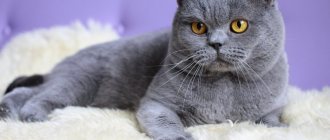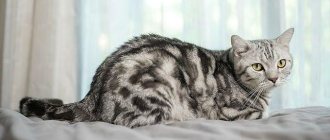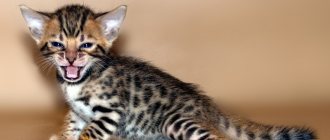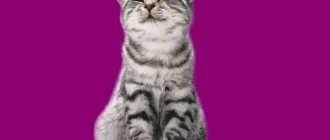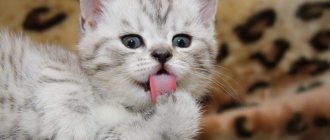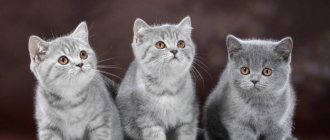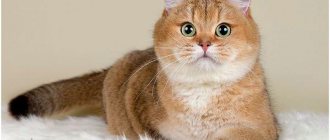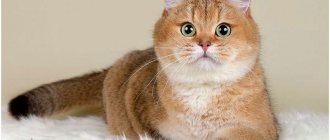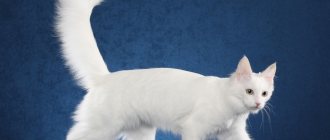History of the origin of the domestic Bengal breed
global $ads_google;
//data-ad-slot=”2475549904″ $ads_google = empty($ads_google) ? false : true; ?> if ($ads_google == false) {?> $ads_google = true; ?> } ?> The goal of breeding the Bengal cat, the founder of the breed, American Jane Mill, considered obtaining a domestic cat that preserved the color of its wild ancestors - this would help focus attention on the serious problem of extermination of leopard cats.
The history of the origin of the Bengal breed began almost 60 years ago, in 1961, when Jane came to Bangkok. This trip became fateful: there she received a baby Asian leopard cat, which is almost impossible to tame. The purchased baby received the name Malaysia and settled down with the new owner. The grown cat gave birth to offspring from a domestic shorthair cat, but the vicissitudes of fate did not allow her to start breeding a new breed.
A new attempt was made by Jane in 1980. She was provided with 9 hybrids of a leopard cat and domestic cats of different breeds. Then Mill fell into the hands of an Indian cat with a golden-orange color, which gave the Bengals a shiny coat called glitter.
The work was long and difficult due to many factors, and ended in success and recognition by the early 90s.
Description and standards of Bengal cats
It is impossible not to notice the external features of an exotic cat. Even when very small, the baby Bengal looks like a leopard. An adult Bengal cat receives the highest reviews and, just from one verbal description, is a true beauty.
According to the WCF standard, the breed must have a number of characteristics.
The head is a wedge with a massive chin and thickened chin pads. Thanks to this structural feature, the animal’s muzzle resembles a tiger’s mouth. This similarity is even more noticeable during yawning, meowing or growling.
The ears are short and set high on the head. They are wide at the base and their tips are rounded.
The nose is large, curved and moderately wide.
The eyes are almond-shaped and very beautiful. Eye color is clear green or golden.
The head is located on a thick and strong neck, which is in ideal proportions in relation to both the head and the body.
A cat of this breed has a large body and strong muscles.
Bengals run around the house on round, large and powerful paws. As usual, the length of the hind legs exceeds the length of the front ones.
The tail is medium in size, does not fluff, and is dense to the touch. The domestic leopard's tail has spots or rings.
Bengals are short-haired creatures with a soft, silky coat.
When interested in a description of a particular cat breed, people who are allergic to the Fel D1 protein first of all find out whether this charming creature is a hypoallergenic animal. Despite the fact that shedding almost does not affect these cats, they themselves carry the entire allergen on their skin.
global $ads_google; //data-ad-slot=”2475549904″ $ads_google = empty($ads_google) ? false : true; ?> if ($ads_google == false) {?> $ads_google = true; ?> } ?>
The breed presents a wealth of colors. A popular color is spotted-striped. This variety has shades of gray, white or red.
The most common and characteristic color of the Leopardette breed makes the cat look like a leopard.
“Sorrel” in cats finishes forming closer to the year. The coat is golden, the spots are chocolate brown, and the tip of the tail is black.
A sign of the marbled variety is spots of a peculiar, non-leopard shape.
Cats in white and gray colors are called "snow leopards". Kittens are born white, only later acquiring their characteristic color.
The colors of the Bengal breed also be called: rosette on gold, rosette on silver, marble on gold, marble on silver, seal links point, seal mink, seal sepia, charcoal, blue.
Glitter and phasing in Bengal kittens
Fazing in Bengal kittens is the process when babies from one month to four months are covered with gray or dull white fur. The name of the process comes from the English word fuzzy - unclear, uncertain. When the baby is more than a month old, the owner suddenly notices that the appearance of the young Bengal is changing. His fur becomes strewn with protruding whitish hairs, and the cat looks shaded. If phasing is severe, it makes it very difficult to see the pattern and color of the skin. The full beauty of the fur coat returns to eight months of the animal’s life.
Phasing does not manifest itself in every Bengal kitten.
The breed is characterized by glitter - a particularly strong shine to the coat. This is not a mandatory parameter for exhibitions; you can purchase a cat with or without glitter, since the standard allows both types for all representatives of the breed.
Dimensions and weight of Bengals
When buying such a pet for a home, the owner should imagine how big a Bengal cat grows. The height of an adult animal at the withers is 40-41 cm. The animal grows to this established norm by 1.5 years, but the complete completion of growth processes is completed by the age of two years.
The typical weight of purebred cats is 3.5-5.5 kg. An adult male is more massive than a female and weighs 5-8 kg. Animals of both sexes are larger and smaller than the declared weight, but this does not happen often.
If a cat seems very large and its weight is quite high, this does not mean that obesity has appeared: Bengals are nimble and energetic creatures, and, most likely, their body weight is due to the pet’s excellent physical shape and well-developed muscles.
The body length of an adult handsome leopard is about 90 cm, and the height at the withers is 40-41 cm.
global $ads_google;
//data-ad-slot=”2475549904″ $ads_google = empty($ads_google) ? false : true; ?> if ($ads_google == false) {?> $ads_google = true; ?> } ?> Table of weight of Bengal cats by month
| Age | Female | Male |
| newborn | 65-110 gr | 70-125 gr |
| 1 month | 350-500 gr | 390-560 gr |
| 2 months | 640-1100 gr | 750-1300 gr |
| 3 months | 1.2-1.6 kg | 1.3-2.2 kg |
| 4 months | 1.7-2.6 kg | 2.5-3 kg |
| 5 months | 2.5-3.1 kg | 2.8-4 kg |
| 6 months | 2.8-3.9 kg | 3.1-4.3 kg |
| 8 months | 3.2-4.8 kg | 3.7-5.1 kg |
| 10 months | 3.3-5 kg | 4.3-5.6 kg |
| 1 year | 3.4-5.2 kg | 4.8-6.3 kg |
| 2 years | 3.5-5.5kg | 5-8 kg |
Coat color
Thanks to its wild color, the Bengal cat has gained worldwide fame. A large list of colors is officially recognized, which is presented in the photo. The main requirement for fur is maximum contrast between the background and the pattern. The paws and tail are always distinguished by a pattern in the form of stripes rather than spots.
Interesting!
Kittens may be born light colored. As you get older, a pattern will emerge. The kitten's final Bengal color appears at 8 months.
By pattern type
The color of Bengal cats is not only multi-colored, but also has different patterns. There are several dominant colors: leopard, spotted and marbled.
Leopard (Rose)
These are the most common colors. Already from the name it is clear that this is a pattern consisting of beautiful spots of “rosettes”. The outline of the rosette is highlighted in black or dark brown. The core is darker than the main fur, but lighter than the outline. The socket can have a closed or open circuit.
Spotted (Spot)
The description of the spotted pattern is quite simple - these are monochromatic spots of dark color located throughout the fur. They should be very bright and contrasting. Usually their size is slightly smaller than that of a socket. There are different types of stains. Most likely they will be round, but there are also oval, elongated spots.
Marble (Marble)
The marble color is much less common than leopard and spotted patterns. The stripes are located along the fur coat, and not across, like the usual stripes of the British. The Bengal marbled cat has spots of various shapes. The main condition is their clear outline. The marbled cat looks more like a tiger cub than a leopard.
By coat shade
The color of Bengal cats is divided into 5 main shades of fur. The golden shade is considered classic. In addition to it, there are silver, snow, blue and charcoal colors.
Golden (Brown)
The main color of the coat varies from golden yellow to light brown. The spots are highlighted in dark brown or black. The eye color is green or golden. The tip of the tail is always marked black.
Silver
The background fur is white, gray or silver, steel. The tip of the tail is also marked with a black spot. The markings on the fur are gray with a black outline. The eye color is green or golden.
Snow
Snow color is further divided into snow lynx, mink, sepia - from lightest to darker. In general, the snow cat has a light fur color - cream or ivory. Sometimes the fur is almost white. The marks can be light, as if faded, or more pronounced - beige, dark brown. Eyes can be blue, green, green-blue, golden.
Snowy colors are valued by breeders. Less often it can be found in combination with a marble pattern.
Blue
The fur is gray with a blue tint. These types of colors are not found very often. The main thing in describing this color is the cold undertone of the coat. The spots are gray-blue or dark gray. The iris color is green, brown or golden. The end of the tail is highlighted in dark grey.
Coal
The main color of the fur is charcoal, dark gray or brown. The Bengal cat in the photo is a perfect example. This photo shows fur with a cool undertone. The spots are highlighted in an even darker shade. Outwardly, it looks like the cat really got dirty in something charcoal-dark. The muzzle has a patterned mask with white circles around the eyes. Eye color is green, golden or brown.
Characteristics of Bengal cats
The appearance of a Bengal kitten in the house expands the horizons of its owners and narrows their horizons to raising one nimble little rascal. The cat's character is bright and memorable: the combination of the natural intelligence of a predator merges with the soft playfulness and sociability of its domestic ancestors.
Reviews about domestic leopards are similar in that these cats are extremely intelligent creatures, so raising and training them is a pleasure. The family favorite remembers commands easily. It doesn't take long to train your Bengal to use the litter box.
The cat’s adaptation to new conditions occurs quickly; very soon the baby will explore all available places and begin to explore forbidden areas. You can compare the character of a Bengal with the character of dogs - he is just as ready to defend his territory, protect his owner, and carry objects from place to place. During the game, the Bengal pet will easily return the abandoned toy, since he himself is interested in spending time with the owner or his child in this way, which is why it is recommended to train the cat.
global $ads_google; //data-ad-slot=”2475549904″ $ads_google = empty($ads_google) ? false : true; ?> if ($ads_google == false) {?> $ads_google = true; ?> } ?>
Cats welcome the company of their beloved household members and are very talkative, but you should not cuddle the animals. Cats are also good with other domestic animals and can make friends with dogs. Bengal girls are well socialized, but they do not approve of communicating with strangers - they need time to understand whether a person entered the house with good intentions.
The animal picks up the mood of its owners very accurately, reacts sensitively to changes in tone of voice, and remembers the words addressed to them.
Raising a cat should start as early as possible. Bengalis are very socialized, they learn understanding and learn about the world from a person's voice. In addition, these cats, like dogs, remember words and are able to follow commands.
They regularly devote time to raising the spotted cat, mainly by playing with the young predator. The game allows the Bengal pussy to show the predatory instincts of a hunter and learn an acceptable behavioral model. Aggressive actions of a cat must be stopped, so it is important to know how to properly raise a cat.
Bengal cats definitely need physical exercise: cats' access to heights is encouraged.
Key facts
The Bengal cat is a popular and expensive breed. These are beautiful, graceful animals, outwardly standing out among other cats with their rare color.
The description of the Bengal cat breed says that these animals love games, walks, and move a lot. They have a sharp mind and can even be trained, so representatives of this breed can be seen among participants in cat agility. Bengal cats are suitable for equally active and experienced cat owners.
The Bengal distinguishes its owner from other people and quickly and easily gets used to the family. He is not aggressive, unpretentious and loves children.
A pleasant characteristic of the Bengal cat: representatives of this breed are clean and, unlike other cats, love to splash in the water.
Bengals are regular participants and stars of exhibitions, favorites of experts and breeders. They are regularly included in the top of various ratings of the best and most beautiful cats.
The owner of a Bengal cat becomes the owner of a pet leopard, which has the grace and beauty of large feline predators, but at the same time is completely safe for living together.
The final advantage is the high life expectancy of the Bengal cat: this large pet can live in good health for 15 years.
Care and feeding of Bengals
A short-haired cat brings less worries at home than its long-haired counterparts, which makes caring for your pet much easier. Keeping and caring for a cat is not difficult: 2-3 times a week, devote a little time to combing the fur, which a soft rubber brush will help with. Sometimes you may not even notice the shedding, but once the procedure has begun, it is better to comb the kitty more often.
The descendant of a wild leopard cat needs to trim its claws once every couple of weeks. The ears are cleaned at the same intervals with a damp cotton pad.
It is also necessary to take care of your pet's oral cavity by brushing its teeth once a week.
The bath easily becomes a favorite place for the Bengal, who happily hits the water with his paws. Washing is allowed in rare cases using special cat shampoos.
Feeding a Bengal kitten occurs from month to month according to the feeding schedule and recommendations of specialists. Good nutrition quickly turns a small cat into a healthy, strong cat.
What to feed a Bengal kitten for 2 months
They also feed raw meat (beef or rabbit), exclude raw offal from the diet, replacing them with boiled sea fish once a week. Dairy products in the form of kefir, baby cottage cheese without any additives, and low-fat cream are useful for cats. The daily food intake also involves the addition of vegetables not exceeding a quarter of the volume of meat products. These are carrots, tomatoes, bell peppers. A Bengal cat can be switched to premium and super premium dry food, which the animals eat with benefit and pleasure.
Keeping a neutered cat involves replacing natural nutrition with specialized food.
Health of the Bengal cat breed
Fortunately, thanks to breeding work and natural hereditary immunity, Bengal exotic beauties have excellent health indicators. But if their immunity resists most feline diseases, then there are some genetic diseases, the fight against which in many cases is quite successful.
global $ads_google; //data-ad-slot=”2475549904″ $ads_google = empty($ads_google) ? false : true; ?> if ($ads_google == false) {?> $ads_google = true; ?> } ?>
The most common phenomenon is “dry nose syndrome.” This problem can occur in kittens up to one year of age. You can't miss a dry nose: cracks and crusts on the surface of the nose become ulcers. In general, this condition is not critical to health and does not cause any special problems for the animal itself. To know for sure whether a dry nose promises trouble, it is better to consult a veterinarian - it happens that this condition develops into an ulcerative lesion of the nose. The doctor prescribes timely treatment that will help restore the healthy state of the nasal surface.
Bengals are sensitive to poor quality food, so to avoid loose stools, the cat is fed only selected food and always provides the pet with fresh water.
There are two serious genetic disorders: hypertrophic cardiomyopathy (HCM) and flat chest syndrome (FCK) in kittens. In the first case, observations and testing are mandatory; proper care will allow the cat to live a long and good life. The second problem is a serious obstacle to the survival of kittens and is looking for a solution. If a Bengal cat was taken from a cattery with a good reputation, where inbreeding and the use of antibiotics by the pregnant female were not allowed, the problem is unlikely to affect her and her offspring.
Miniature leopards are vaccinated according to a schedule starting at 8 weeks. All vaccinations are prescribed by a veterinarian.
The life expectancy of a healthy Bengal cat is 14-16 years if it lives under the supervision of attentive and caring owners.
If the cat was taken as a family pet, then you need to monitor the onset of puberty in order to castrate or sterilize the animal in time. The first heat in a Bengal cat occurs at 6-8 months, when the female’s weight reaches 2.5-3.3 kg. Cats “grow up” by 9 months. If you want to get offspring from your pet, you need the obligatory assistance of a specialist in breeding, otherwise even a successful mating, healthy pregnancy and problem-free childbirth do not guarantee full-fledged offspring.
Hereditary diseases
In addition to infections, any cat is susceptible to genetic diseases. This problem has not escaped the Bengals either. There are several types of most common diseases.
Gastrointestinal problems
This is a problem of the first order. Bengals have a sensitive stomach and a shortened intestinal structure, characteristic of wild cats. They are susceptible to food poisoning. It is difficult for animals to choose food; it is rarely possible to do it the first time. Any new treat causes digestive problems and changes in stool.
Here, owners will have to be patient and give preference to holistic or premium food. It is better to coordinate the new menu with the veterinarian, informing the doctor about the pet’s problems.
Progressive retinal atrophy
The disease is painless for the cat and unnoticed by the owner. Gradually the retina of the eye dies, leading to complete blindness. It's not always clear why this happens. Usually the disease is diagnosed at the age of 5-6 months. It can be stopped early to avoid big problems. Nothing can be done about the chronic form.
The first symptoms are night blindness, avoidance of dark rooms, slow movements, lack of reaction to a change of environment (crashes into a new table or jumps onto a cabinet that no longer exists).
Hypertrophic cardiomyopathy
Cardiovascular disease can be congenital or acquired. This is a tendency to heart disease, which is provoked by one of the thickened walls of the myocardium. In the early stages, the disease is not diagnosed during a standard examination; there are no symptoms. If left untreated, it can cause sudden death.
For this reason, it is important to conduct an annual cardiac ultrasound and ECG to ensure that your pet does not get worse. With medication support and a calm lifestyle, the cat will live a long life.
Important!
These diseases are rare. Despite this, it is important to monitor the animal’s condition in order to prevent the development of a chronic form of the disease.
Buy a Bengal kitten
Nurseries where you can buy a Bengal kitten are quite common in Russia. You won’t be able to save money on buying a descendant of a wild Asian leopard cat if you want to buy a purebred animal that will strictly meet the standards. In the nursery, the buyer will learn all the information about the future cat, its pedigree, and hear interesting facts about the character of the domestic mini-leopard.
The cost of the Bengal remains high precisely because of the difficulties with breeding. The first generation of Bengals will be infertile if they are males. Females of the first generation are crossed with Bengals and a second generation is obtained, where most of the males are sterile. In the third generation from the f2 female, only some males are sterile. The fourth generation are considered true representatives of the Bengal breed, and have a full range of characteristic skills and traits.
The price for a Bengal cat in Russia is:
- pet class
25,000-50,000 rubles; - breed class
50,000-100,000 rubles; - show class from
100,000 rubles
.
What to name a Bengal kitten
When a Bengali boy or girl arrives in the house, the family may have a number of names ready. But before you give the kitten a nickname, you should know that it must begin with the same letter as the name in the passport.
global $ads_google; //data-ad-slot=”2475549904″ $ads_google = empty($ads_google) ? false : true; ?> if ($ads_google == false) {?> $ads_google = true; ?> } ?>
Also, you should not give a new cat the nickname of your previous pet, this is not only a bad omen, but also a careless attitude towards the memory of a deceased or missing pet.
A long name is difficult to pronounce and difficult for a cat to remember. Hissing sounds are welcome, to which the cat will react most quickly. You can experiment and try calling the cat by different names. There is a chance that the animal will choose its own name.
Handy tables have been created with names that might be suitable.
| Girl | Boy | ||
| Julie Dosya Cleo Dotty Shelma Ivy Eva Aida Stesha Fanta Vikki Iksa Yesya Lika Liya | Almira Brandy Toffee Yuni Tori Lynx Klepa Cher Goldie Ulfi Bara Baksa Goldie Lucky Finka | Joshua Joe Alistair Leo Easy Bingo Ike Luntik Wirt Tory Rain Ride Whiskey Martin Ralph | Vince Rick Jacques Mort Indie Byte Drake Knight Spot Fima Gore Chen Zipper Gizmo Weiss |
How to choose a kitten, its cost
There are kittens of the early generation (basic Bengals F1). One of their parents is a wild leopard cat. The kittens retain the wild habits and distinct external characteristics of a wild leopard cat. In terms of size, they can be larger than ordinary cats. They are not suitable for exhibitions. Usually they like to buy them for breeding in order to improve the overall gene pool.
A more budget option is SBT-Bengalis. Their wild ancestor was in the fifth or more distant generation. The four previous generations of Bengal cats and cats consisted of purebred pedigree Bengals. Such kittens are more flexible, affectionate, and get used to being handled more easily. Outwardly, they are more reminiscent of domestic cats, but even here you should be prepared to show character.
Important!
The optimal generation characterizing a purebred Bengal is F4-F7. Sometimes kittens are reserved immediately after birth, because... This species bears 1-3 kittens.
The breeder must provide a pedigree, a vaccination passport, and may need the results of tests and studies confirming the health of the pet.
To choose a healthy kitten, you need to know the signs of a healthy animal:
- clear, open and interested look;
- lack of mucus in the corners of the eyes;
- smooth and beautiful fur, without bald spots or tangles;
- confident gait (if the baby is less than 3 months old, hesitant behavior is allowed);
- interest in guests, lack of aggression in the kitten and mother;
- the breeder must show the kitten’s mom and dad so that there is no doubt about the purebred of the breed;
- You should definitely meet the breeders and animals face to face.
Many people are interested in exactly how much a kitten costs. However, it is impossible to give a fixed price. The minimum cost of a kitten is 20-25 thousand rubles. The price can rise to 60-100 thousand rubles. If the animal has minor defects, it will cost less. If the pet is planned to be used for breeding, the price will be higher. The cost depends on the rarity of the color.
It is better to purchase females for breeding, and males for exhibition careers. Kittens are adopted no earlier than three months of age. At this point, they easily switch to solid food, are trained to the tray, and have the necessary vaccinations.
Important!
To buy a Bengal, it is better to find an official nursery where kittens are taught to be handled from birth. Cats cannot be kept in enclosures.
Conclusions about the breed
The Bengal cat deservedly receives praise and admiration, but not only due to its chic external characteristics:
- The cat's character is ideal for sociable and sensitive people. Both adults and children can play with the furry baby;
- if the owner does not have time to care for the cat, then it is better to opt for a less demanding breed;
- without experience it is not worth breeding cats;
- a well-developed intellect only pleases;
- the cat does not like to be squeezed;
In general, Bengals have good health and delight with their intelligence.
